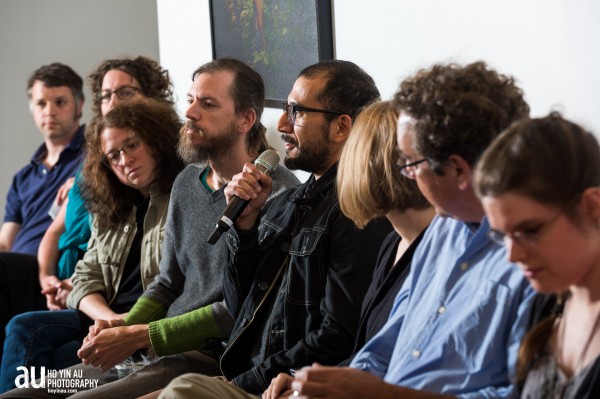
From the “How we get by” event. Left to right: Tim Devin, Andi Sutton, Heather Kapplow, Dirk Adams, Dave Ortega, Melinda Cross, Gregory Jenkins, Emily Garfield. Not pictured: Coelynn McIninch, Greg Cook, Jason Pramas, Shea Justice. Photo by Ho Yin Au
Last week marked the first anniversary of Getting by in Boston, or “GBIB” for short. It’s a series of meetings, an online forum, and a handful of related groups—all focused on how creative people (artists, writers, musicians & how) can survive in our famously expensive little Boston. The whole thing is pretty DIY, with different people taking the lead when they want to. And, weirdly enough, it all grew out of a single event that took place last June 4th.
That event, which Jason Pramas, Matt Kaliner, and I put together, was supposed to be a one-off thing. It was called “How we get by,” and featured 10 well-respected artists talking about how they make ends meet, and how they find the time and funds for their artwork. This was breaking some taboos, since creative folks don’t usually talk about how they pay their bills. First, it’s not how they identify themselves; second, there’s this weird notion that successful artists earn their keep from their art, so most people aren’t really upfront about the fact that they work—since it implies they’re not “successful.” So image everyone’s surprise when all but one of the speakers talked about their day jobs and their problems making ends meet. (Here’s an article I wrote about the event for the Mass. Cultural Council, and here’s Edmond Caldwell’s review of it for Big Red and Shiny.)
Over 100 people showed up for the event. There was a lot of energy there, so the next day, Jason, Matt and I set up a discussion group on Facebook called “Getting By In Boston.” After a few weeks, we also started organizing some follow-up meetings. Between the online forum and the in-person meetings, there were a lot of interesting discussions. And even some real-life outcomes.
—-The issues—-
More on the other meetings in a minute. First: what have the GBIB people been talking about? Well, there’s been a lot actually, which makes summarizing it pretty hard. But here are the four biggies:
- Community. Folks have been really interested in learning from each other, and figuring out ways to help each other out. There’s also been talk about the need for a greater sense of community among creative people. This surprised me at first, but it makes sense given how fragmented the creative scene really is.
- Money. No surprises here. The first event revolved around how few arts-related jobs there are, and how hard it is to try build a career in any given creative field—and how much work people are doing for free in the hopes of establishing a reputation that will lead to these things. This led to discussions about how little money there is in the local creative system in general, and how expensive it is to live around here—which is the reason so many talented people leave. Some solutions: coops, and sharing resources.
- Political situation of creative folks. One big thing that I was glad to see come up is the need for creative folks to band together and fight for what they need. There were lots of discussions about arts funding, zoning as it relates to us creatives, and social issues such as racial divides. For example, when I was getting ideas together for this post, Greg Cook told me that “Getting By helped clarify feelings I’d long had about the inequality (financial, gender, racial, sexual, age, geographic, etc.,) that so dominates the creative worlds—but perhaps previously I didn’t have the right words for.”
- Physical space. The high cost of living is the number one issue facing everyone who lives around here, not just us creative people. But the way this plays out for us is there aren’t many venues for producing and showing work, and the ones that do exist don’t last a long time. Just like our apartments. An online poll I put together last year showed that space was at the top of GBIB’s list of concerns; and posts by people looking for space, or announcing a space is closing are pretty common on the FB page. Rising rents force us to move around, which makes us complicit in gentrification—another topic that’s gotten a lot of play.
(There’s no way I could do justice to the whole discussion, so if you’re interested in learning more, take a look at the FB discussion group.)
—-Then there were a whole bunch of meetings—-
Like I mentioned, there was a lot of energy after the first event. But what should happen next? Did people want to move forward and get organized? Or were there existing groups or organizations that we could get involved with? Or both? At the first follow-up meeting, the consensus seemed to be that there were some wonderful organizations working already, but that we should focus on some of our own needs. We met again a few weeks later at Aeronaut (which Jesa Damora helped set up, after our first location fell through at the last minute); over beers, we discussed how we could organize ourselves, and a few people like Jason Pramas and Nancy Anderson pitched specific ideas.
—-So what’s come about of all of this? Meet the GBIB family—-
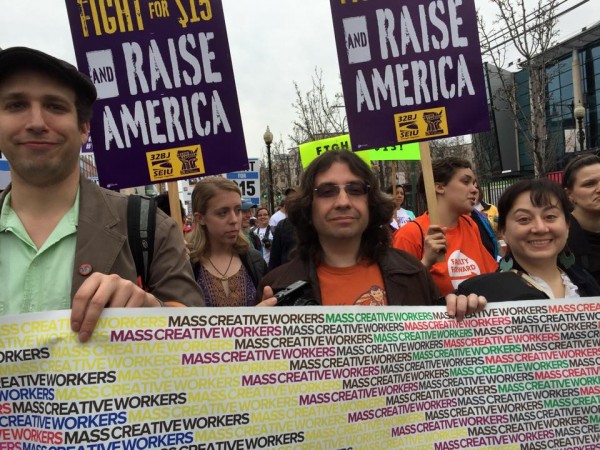
Mass. Creative Workers at the April 14th rally for living wages in Boston. Jason Pramas is in the center; Loreto Paz Ansaldo is on the right.
Mass. Creative Workers
One of the ideas we heard about at that third meeting was Jason’s concept of an association to “take action to improve wages, benefits, and working conditions in several creative industries.” A number of GBIB people signed on, and they began meeting regularly, calling themselves the Mass. Creative Workers. Among other things, they marched as part of the April 14 demonstration for fair wages in Boston. Anyone interested can go here for info on upcoming meetings and actions, or email them at masscreativeworkers@openmediaboston.org.
Off the Wall
Nancy Anderson also pitched an idea at the Aeronaut meeting. She was concerned about how hard it is to find a place to show your work, since there are so many artists competing for precious little gallery space. She wanted to match artists looking for places to show their work with businesses with wall space. She’s since partnered with Somerville Open Studios, and is about to go live (stay tuned). Off the Wall is a complete service for both the artists and the businesses: it curates the work, handles arrangements (including selling the art), promotes both the artists and business-partners on social media, and rotates work on a regular basis. You can email her at canis_major@mac.com for details.
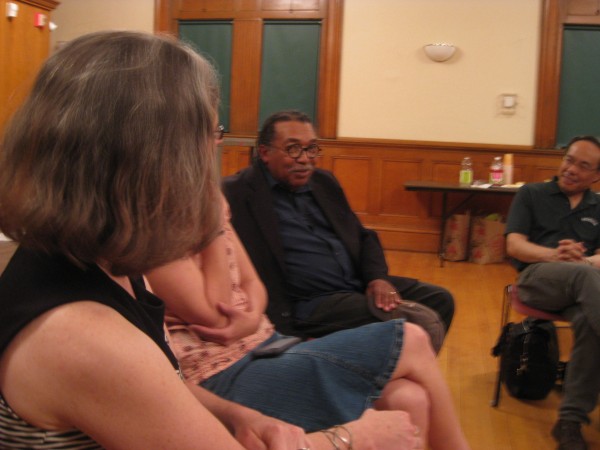
The first “how to be an artist and a parent” event. Speaker James Montford is in the center. Speakers not pictured: Paige Wallis and Stacy Thomas-Vickory.
How to be an artist and a parent?
One theme of the GBIB discussions is how to make ends meet, and still have time for creative work—something parents who are artists or writers or musicians feel pretty deeply. This realization led Greg Cook and me to start a series for creative parents called “How to be an artist and a parent.” We’ve had two events so far, and there’s also an online forum here. The idea is to swap notes on how to juggle our competing interests, how to manage time better, and to maybe find ways to help each other out. If you want to get involved, join the discussion on our Facebook page, or motor on over to our website here. You can read Greg’s summary of our first event here, and my article about the second one here.
Artists and Writer’s Mutual Aid Society
Another concern for GBIB folks seems to be a need for more community, and maybe some helpful motivation along with it. Be Be (aka Brenda Be) organized an event in Somerville last November along these lines, and called it “The Artists and Writers’ Mutual Aid Society.” She is currently reorganizing the idea as a regular series of monthly meetings. In addition to fostering community, this new group will be a place to find collaborators, share advice, and brainstorm. You can get involved by joining the FB group here.
—-The bottom line—-

Peyton, the GBIB mascot.
But besides some discussion meetings, a few new groups, and a whole lot of online chatter, what’s actually been accomplished?
Each creative form has its own niche community in Boston; as a result, people who could be working together not only don’t know each other’s needs—they don’t even know each other’s names. So it was interesting to see GBIB bridge this gap for a number of people. “It started with the visual arts,” fellow organizer Matt Kaliner told me, “but the later meetings did connect with theater a bit, especially after the closing of the Factory Theater.” And once that gap was bridged, people started realizing the challenges they face were related. Matt again: “I was really struck by the similar problems across genres.”
It’s also become a place where people discuss social and political issues. Beyond all of this chatter—and, most likely, because of it—I’ve seen GBIB folks at rallies and open meetings on arts funding, as well as more in-the-weeds things like meetings on Somerville’s new zoning code, and talks on artist-led gentrification.
Besides these shows of force, this energy has translated into at least one win: a new grant category. At “How we get by,” Heather Kapplow mentioned that the Mass. Cultural Council’s grants program supports a large range of media—but didn’t really address interdisciplinary work. This is important, since interdisciplinary work is arguably some of the most innovative (since it plays with different forms) and the least supported (because it doesn’t fall into existing grant and exhibition categories). After the event, a number of us (Philip Fryer, Andi Sutton, Kathleen Bitetti, Heather and myself) decided to approach the MCC. They were very receptive, and got back later in the summer to say that they’d expanded the sculpture/installation category to include “new genres,” which is specifically designed to provide an option for those working across disciplines.
Which I think is a lot for one year. But then again, I’m biased.
—-What’s going to happen in the next year?—-
The group has been going off in different directions lately, but that seems like a good thing: people are getting down to working on the part of the problem they think is the most important. So if one of the four existing groups appeals to you, get in touch! We’re all pretty open people.
But of course, there are tons of issues that affect us here, so if something’s bothering you beyond those four issues, we hope you’ll bring it up on the forum. Maybe others will agree, and we can get started on it. Let’s make it happen.
Special thanks to the folks who let me pick their brains: Brenda Be, Coelynn McIninch, Greg Cook, Heather Kapplow, Jason Pramas, Matt Kaliner, Michael Goodman, MJND, and Nancy Anderson.
Last weekend I joined the newly formed collective,
The People’s Microphony Camerata, founded by
Elana Mann and
Juliana Snapper. I signed up because of they said we would perform scores inspired by the People’s Mic and the Occupy Movement, which has fascinated me since I first experienced it during the Brooklyn Bridge arrests. However, I was a bit hesitant when I realized they considered it to be a
Choir. To the dismay of my Grandma, Edith, who sang at
the Stage Door Canteen in NYC, I don’t sing (at least not in public).
But… I stuck with my commitment and half way through our second day of rehearsing and workshopping scores I realized I was enjoying myself and the sound of our collective voices. I was singing.
You can hear the results of our first recording session as it will be played on Sunday as part of
Radio Break, “an exhibition on the air, presenting twelve artworks in locations throughout Los Angeles conveyed through low-power radio transmissions during two weeks and live events held on two consecutive weekends,” curated by students in the
USC MA Art and Curatorial Practices in the Public Sphere program.
Radio Break started last weekend, so you may have missed some of it, but here’s this weekend’s schedule:
SUNDAY, APRIL 22nd
All events at 6020 WILSHIRE (The new ForYourArt space), 6020 Wilshire Boulevard, Los Angeles
2–6pm
Richard T. Walker intervenes into Los Angeles’s visual and radiophonic space, telling the absurdist tale of one man’s quest to find the words to speak when language no longer suffices in between distance and a mountain.
3–5pm
Tune into the concerns of Angelenos affected by the financial crisis by listening to the carols of the People’s Microphony Camerata (Cynthia Aaron, Karen Atkinson, Vivian Bang, Andrew Choate, Judith Dancoff, Rachel Finkelstein, Penny Folger, Sascha Goldhor, Michele Jaquis, Allison Johnson, Elana Mann, Kimberly N, Alanna Simone, Juliana Snapper, Julie Tolentino, Annette Weisser and Becca Wilson).
6–9pm
LIVE PERFORMANCE and RECEPTION
David Schafer‘s Cage Mix: Static Age reconceives a selection of John Cage’s compositions through live electronic and processed improvisation performed alongside an accompanying installation. A reception will follow Schafer’s performance.
A listening station with all projects will be at 6020 Wilshire through April 27th.
I just got back from NYC Sunday night. I was there for the Partnership for Academic Leadership on Sustainability Summit, but had plans to stay the weekend and enjoy the city. After visiting galleries in Chelsea on Saturday I met up with my friend, Evan, to see what was going on with Occupy Wall Street, also on my list of possible things to do. We got there a little after 3pm and the protesters were marching north, so after watching for a few minutes we joined them. There were so many people there – all different ages, races, genders, backgrounds, etc, all protesting for the same list of grievances mainly representing the 99% of Americans who are being harmed by Capitalist/Corporate Greed. People were chanting things like: “Banks Got Bailed Out! We Got Sold Out!” and “Whose Street? Our Street!” and “We Are the 99 Percent!” and “Hey Hey! Ho Ho! Corporate Greed has got to go!” There was even some chanting, “We are Troy Davis!” It was exhilarating to say the least.
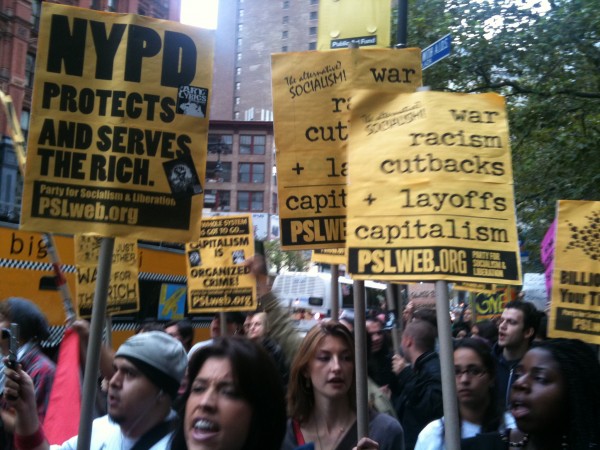
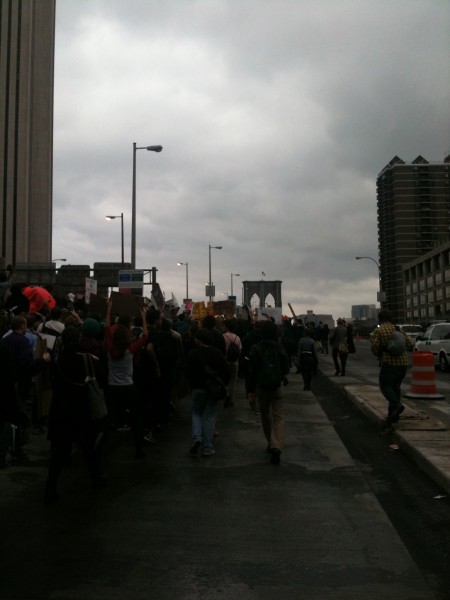
As the parade took a turn east we realized we were headed for the Brooklyn Bridge. All along the cops had been standing between the traffic and the protesters, calmly keeping us on the sidewalk, but once on the Bridge the protesters split up between the pedestrian walkway and the road. Evan and I had started on the pedestrian side, but after I leaned over to take a picture of the crowd on the road we climbed down to join them. It seemed sanctioned. I wasn’t sure what would await us in Brooklyn – speeches? A rally? Nothing? Either way Evan lived there so we figured afterwards we’d just keep on going to his apartment.
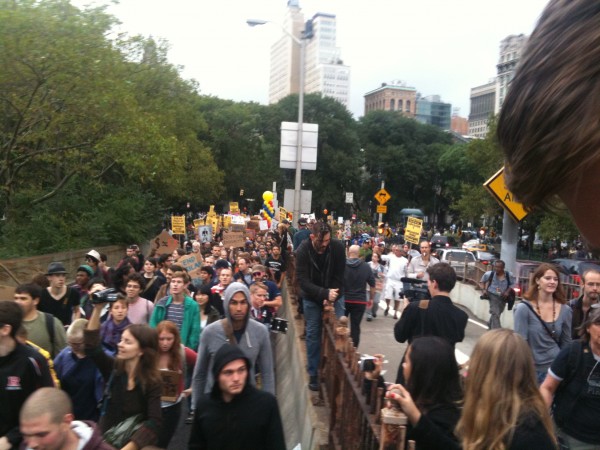
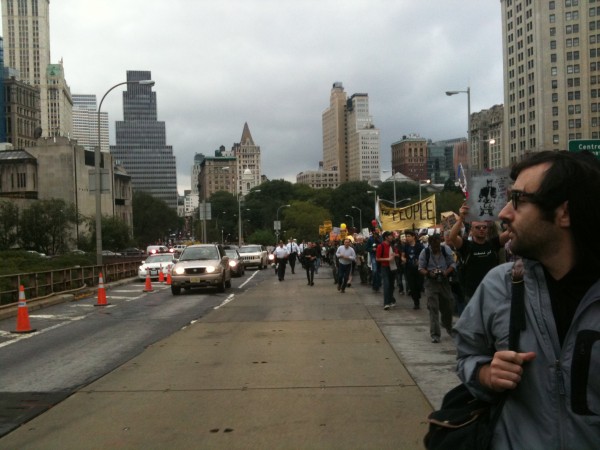
I felt the power in our numbers and I felt protected by the cops, who appeared to be escorting protesters onto the road, allowing us to block one lane of traffic while cars slowly moved along side us in the other lane. Video footage that I saw later that night, show the cops leading the march over the Bridge as they walked in front of the parade. While conflicting reports say the cops were telling protesters they would be arrested if they marched on the road, I certainly didn’t hear them. It’s hard to tell if they led us on, in order to trap us, or if they were just overtaken because of our numbers. By then the chants had evolved into “Whose Bridge? Our Bridge!” and “The whole world is watching!” It felt momentous and I was proud to be there.
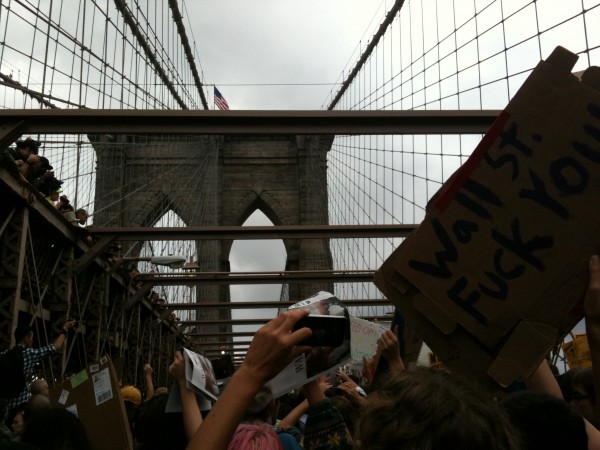
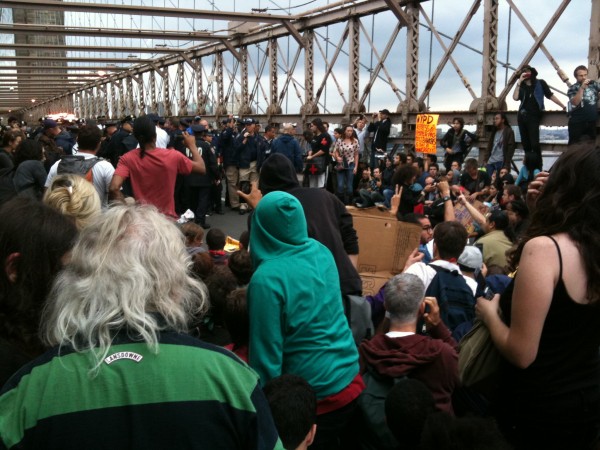
About two thirds of the way over the bridge there was a sudden rush backwards by a few, while the rest of us stood our ground. Some people started climbing up the railing onto the pedestrian side, while others yelled for everyone to sit down in passive resistance. Next we were surrounded by cops, and they were telling people not to climb up. I wasn’t sure at first if we were in trouble or if the cops were just trying to protect us from falling into the East River. Then they were unfurling their orange nets and corralling us into the center from all sides – this tactic of “kettling” has been used by the police during protests in Europe and Canada, most recently in London. I saw a few protesters being escorted out with plastic handcuffs but for the most part most people were just standing around not sure what the cops wanted us to do. Instructions from the crowd alternated with “Everyone, sit down!” to “Stand up! Stand up!” It was confusing. We also got conflicting information and advice from some of the cops we spoke to – some telling us that we might be allowed off the bridge and couldn’t possibly be arrested because “there are too many people for us to process.” While others stood with blank, stoic faces of authority, implying that we were all doomed. People began shouting out a phone number and writing it on their arms. Evan and I couldn’t hear it so we just made sure we both had his fiancé, Liz’s number written down in case our phones were confiscated. The cop next to us told us not to write it on our arms because that would make us more of a target to be arrested. While other protesters insisted that the papers would be taken, so I put mine in my underwear. I was impressed with how calm the cops were and how many seemed to sympathize with us, explaining that they knew their pensions were at stake but that they were just doing their job. One even gave us continued instructions under his breath and wanted us to get the attention of a young protester he had been helping earlier. At one point he told us “Be ready to run to the other side if I tell you to.” It was tense, but I wasn’t scared. Somehow I trusted that we were doing the right thing and wouldn’t be punished for it, or at least felt that if we were going to be arrested it would be a mere inconvenience and wouldn’t be enough to make me regret participating.
After standing around for a while waiting for the unknown, a man from the pedestrian bridge above yelled “Mic Check!” and the crowd below repeated his words. Apparently this has been the tactic of the Occupiers while in Zuccotti / Liberty Park because the NYPD have not allowed them the use of a PA system or electric generators. After the “Mic Check” a call and response continued as the man relayed information about what was happening on the Manhattan side of the bridge. A few words at a time, the crowd repeated his words, hence amplifying them for everyone to hear. It was a pretty powerful thing to experience. He told us to wait patiently and that the cops were escorting us one by one off the bridge. He told us that we wouldn’t be arrested, just removed. The crowd started chanting “Let Us Go! Let Us Go!” and the man’s ongoing instructions seemed to alternate between calming and inciting us.
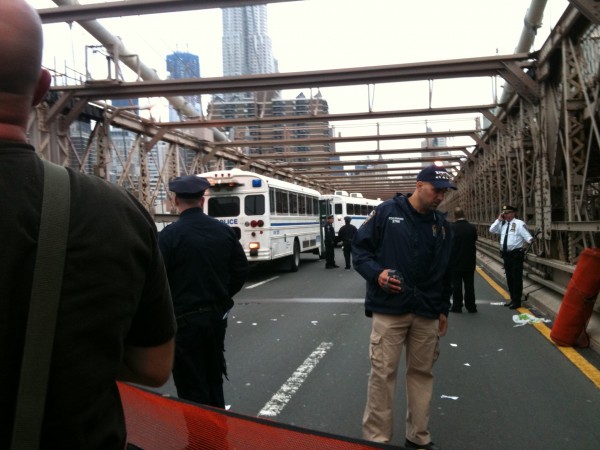
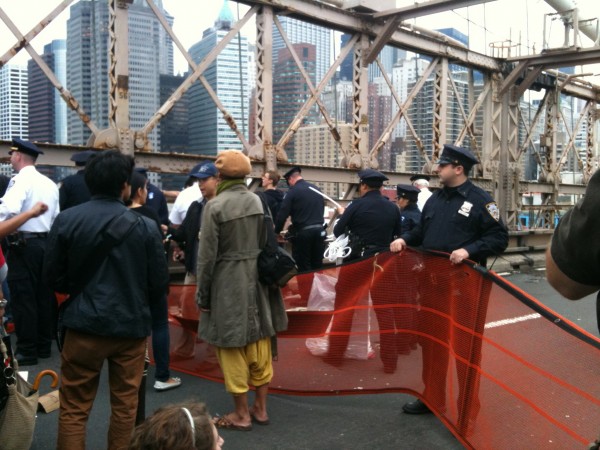
At that point I noticed that all traffic on the eastbound side of the bridge had been blocked and the road behind us was filling up with white NYPD busses. I could see that the cops were lining people up on the south side of the bridge, padding them down, cuffing them, giving them back their bags to hold behind their backs, and escorting them onto the busses. Evan and I watched this for a while and although he hesitated I said, “let’s just get this over with.” We walked towards the cops and lined up with others waiting to be frisked. A few girls in front of us were visibly upset and explaining to the cops that they were college students from Bard. The cops counted them off and let them walk off the bridge hand in hand. There was an uproar from the crowd and a woman behind me yelled, “I’m a college student too!” So I yelled, “I’m a college professor!” not expecting anything to come of it. Next thing I knew the cops were counting off a few more women, me included, and told us to step aside. Next we were told to hold hands and walk off the bridge and to not let go of our hands until we reached the end of the busses. We were all confused; we didn’t know if we were going to be told to get on a bus or not. It wasn’t until we got closer to the last bus that we realized they were letting us go. I texted Evan to tell him and he responded, “I think I won’t be. Can you call Liz?” Some of the women I was with were pissed for being released while our male friends were still being detained on the bridge. I was worried about Evan, but relieved to have been released and able to call Liz and tell her what was going on. It was around 6:30pm by then.
After speaking to Liz, I waited in the rain on the Manhattan side of the bridge for a long time until my phone battery was clearly dying. I went back to my hotel in Chelsea to charge it and kept trying to reach Evan, with no avail. Liz called once she got home and said she had biked downtown and saw the busses containing all the protesters. She couldn’t tell if Evan was in any of them, but could see that the bridge was pretty much empty. Several hours later she heard from him, via text, that he hoped to get out that night. He wasn’t released until 1:45am. He told me the next day, “It kinda sucked, but in the end I’m glad it happened. The braces were super tight & I was in them for 5 hours… then 3 [hours] in a cell with 6 other guys.”
By now you’ve all seen the news reports. Democracy Now! Is calling this “one of the largest arrests of non-violent protesters in U.S. history,” with over 700 protesters detained. I’m glad to be home safe and sound, and understand my husband’s concerns that “it was a stupid thing to get involved with while traveling out of state,” but I’m proud to have participated and can’t deny its importance.
I am the 99%. I was raised in a single parent household on food stamps, free lunches, and unemployment benefits. I was educated in public K-12 schools and private colleges with extensive financial aid. I know what it is like to go to a low income health clinic because I couldn’t afford health insurance. I know what it is like to have to (illegally) purchase medications from Canada because the American pharmaceutical companies lobby the FDA against providing our citizens with access to generic drugs. I am dismayed that once married our allowable student loan tax deduction was cut in half. I am discouraged to see my students drop out of college, because the tuition is too high, and their financial aid package has decreased. I am annoyed that Bank of America has decided to charge customers $5 a month for debit card purchases in order to decrease fees for corporations like Wal Mart. I am furious that federal money is spent on war instead of education, social services and environmental protection.
Yet I am inspired by the power of collective action and proposals for alternatives to Capitalism and Corporate Greed. This is the NGB spirit.

It’s been an exciting time for the future! This summer, we had our Future Information table at a number of festivals, and interviewed over 20 people about the future. We’ve included them on the “History of Somerville, 2010-2100” website. Take a look if you get the chance! (Timeline combining all of the predictions is here. Archive of predictions people have sent in is here.)
Here are some of the new facts about the future you might find interesting:
– In 2036, the Union Square branch of the Green Line is extended down Somerville Ave. to Porter Square .
– In 2060, the city’s DPW goes bankrupt. Davis Square is overrun by the cows and goats that the city now keeps to clear away garbage and mow the grass.
– By 2030, Somerville has become a mecca for singletons. They take the place and apartments of the families that are leaving town because of the poor quality of the city’s public schools.
– By 2100, Somerville has channeled the rising floodwaters into planned waterways. Gondoliering becomes a popular occupation, and a new festival (Gondo Fest) joins the Fluff Fest in residents’ hearts, minds, and calendars.
We’re still collecting predictions! If you’d like to make a prediction, just email Tim at future.of.somerville@gmail.com , or visit the website for more details.
Thanks!
—
About the project:
“The history of Somerville, 2010-2100” is a community art project that is exploring what the future might be like. We’ve been talking to current and former residents; gathering official plans; and collecting think-tank vision statements.
This project is organized by Tim Devin, and is sponsored in part by the Somerville Arts Council.
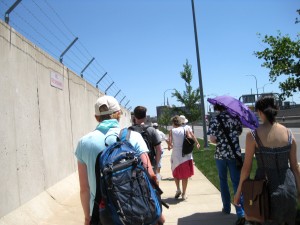
Walking near barbed wire and blast walls. Photo by MN.
A single sidewalk connects all of Logan Airport’s terminals with each other, and with the MBTA’s Airport Station. This sidewalk runs past barbed wire, flower beds, busy sliding doors, and walled-up access roads. Millions of people pass it each year, but few ever stop to notice it.
On Saturday, June 19, 2010, about twenty people joined me for a group exploration of this sidewalk, as part of the Common Boston festival. There were a few architects and urban planners along, as well as a man named Mike who’d grown up near the airport in East Boston; a pilot named Patrick who’d written a book about Logan’s history; some people involved in making public space more walker-friendly; and a number of other interested local residents. MassPort’s spokesperson, Kay, was nice enough to join us as well.
We set out from the MBTA station, and walked about a half mile along a lonely access roads towards the first terminal. Along the way, I gave a brief overview of the airport’s history; Patrick and Kay added a number of details. Kay also passed around internal MassPort maps of the area, which she’d brought along for us to look at. These maps filled in a lot of blank spots for me; when I was doing research for the tour, I was surprised by how many things I couldn’t find out about the airport’s structures.
At the sight of the first pieces of barbed wire, the subject of airport security came up. We talked about blast walls and barbed wire; 9/11; the airport’s history of terrorism, terrorist attempts, and sensational arrests of people who were thought to be terrorists; terrorist watch lists, and the Department of Homeland Security; and the fact that I’d had to provide MassPort with a list of the names of everyone who had signed up for the tour (presumably so that MassPort could do background checks). Opinions on these topics varied.
As we walked, Kay and I told everyone about Logan’s architectural history. Patrick added information about a number of buildings, such as the fact that Terminal E had been extended out, which explained the strange cul-de-sac at the building’s southern end. As a group, we examined and discussed the fenced-off areas for dogs (known as “PetPorts”); the airport’s special trash barrels (known as “bomb barrels”); and the strange open areas in front of the terminals. We also stopped and looked at each terminal building; the consensus was that not many of the buildings seemed designed to be looked at from the street.
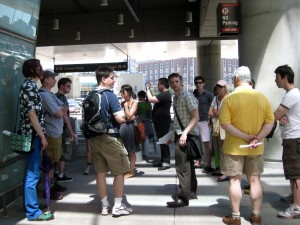
Sidewalk talk. Photo by MN.
In front of Terminal B, we discussed 9/11 again, since two of the hijacked planes had flown out of Logan. I also talked briefly about the airport’s rapid expansion in the 60s and 70s into local residential neighborhoods, parks and nature preserves; as well as the resulting community protests (people laying in front of bulldozers, etc.), and the government’s backlash against them (marshals closing off entire residential areas, etc.). Mike, who’d grown up nearby, followed up my historical lecture with a number of more personal details. Kay then told us about the good that MassPort had done for East Boston in the 80s and 90s—such as paying for soundproofing homes and schools, and funding a park or two.
My tour ended at the front of Terminal A. Kay then volunteered to show everyone the third-floor walkway connecting Terminals A and E, which has a great view of the airport and the city. It also overlooks the 9/11 Memorial. We discussed 9/11 again, and then everyone went their separate ways.
This Tuesday, December 8, the Los Angeles Unified School District Board of Education will be voting on whether or not to cut 50% of all elementary arts education, with 100% cut the following school year. We cannot let this happen!
Please sign this petition and forward it on to anyone you know. This is too important to ignore, so make some noise and spread the word!
This Saturday (12/5/09) I will be participating in an experimental performance event, organized by Jerri Allyn and Inez Bush. Debating Through the Arts is designed to explore creative solutions to cultural issues, and will be held from 9am – 5pm at the 24th Street Theater: 1117 West 24th St., LA 90007
Recommended times to attend:
9am for Artists Debates (will run approximately one hour)
3pm for Creative Proposal Performances (will run approximately one hour)
Audience members are also welcome to participate throughout the day in collaborative brainstorming workshops.
This daylong theatrical event based on the Model United Nations paradigm, includes 4 teams of artists acting as UN Delegates, while creatively debating the pros and cons of Freedom of Expression and Gentrification vs. Cultural Equity.
Participating artists include: Marjan Vayghan • Shana Nys Dambrot • Micol Hebron • Marissa Mercado • Michele Jaquis • Rosalyn Myles • Carol McDowell • Marcus Miceli • Juna Amano • Trinidad Ruiz • Beth Peterson • Jay McAdams • Portable City Projects with Jules Rochielle, Fred Portillo and Flora Kao
The whole nomination of Sarah Palin has seemed like a joke to me, a sleazy effort by McCain to seem like a “maverick.” “Ooh look – I took a chance. I hired a woman! I’m just as progressive as Obama. I’m with it.” (Hear Saddam Hussein as portrayed in the South Park movie with out the homosexual undertones, he is republican after all). Whatever old man. The rest of the women in this country are not fooled.
Today while driving home from work, I thought I had missed the march, that the heavy traffic through downtown was just the tail end. I came home and went about my business, but later when I turned on the TV, I learned that the American Apparel marchers were heading down Alameda. The news reporter called them “a splinter group” that had illegally marched without a permit off the planned route. I guess she didn’t recognize their Legalize LA t-shirts and it didn’t occur to her that they were probably just heading back to work at the factory. I had the sudden urge to join them. They were at Alameda and 1st. I looked for my sign from the march in 2006, grabbed my phone, my ID, debit card and keys, (what else could I need?) and ran out the door. I got to the corner of Alameda and third just as the group was passing through the intersection. I stood at the corner short of breath, holding my sign as high as I could. I got some stares, a few honks and some glares from the numerous cops. Once they passed through the intersection, I ran across the street to join them. I asked one woman holding her child, “Vamos a American Apparel?” after she looked confused when I asked in English. She smiled and said “yes” and I kept walking. Soon a young guy ran up to me and asked if could talk to me. He said he is writing for the American Apparel blog. He was shocked and thrilled to see a white person amongst them. I told him my story and reasons for being there, that I was told that my great-grandmother came here on a fake passport. Who knows if it is completely accurate, but regardless she left Eastern Europe in search of a better life – how is that any different? We agreed this is not a Latino issue, it is an American issue and that South and Central America are still America. Wilmer gave me a bottle of water and recorded a sound bite for his blog. He took my number and we talked the whole rest of the way to the factory. At the gate I shook his hand, although he invited me in for tacos, I had to get back to work. Thanks Wilmer!
One of my crazy friends and his crazy artist friend did something either really stupid, or completely brilliant. They launched a replica of a Revolutionary War submarine in the East River, very close to a British Cruiseliner, the Queen Mary 2. Art or Terrorism, or just a stunt?

















